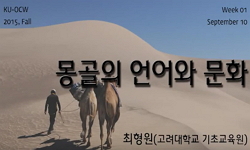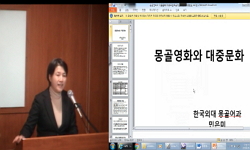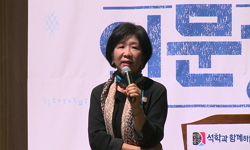The diplomatic and cultural exchanges between the Y㉨an Dynasty(1206-1368) and the Koryeo Dynasty in Northeast Asia since the twelfth century exerted a great influence on the changes of the dominion of this region and Buddhism. Especially, the common...
http://chineseinput.net/에서 pinyin(병음)방식으로 중국어를 변환할 수 있습니다.
변환된 중국어를 복사하여 사용하시면 됩니다.
- 中文 을 입력하시려면 zhongwen을 입력하시고 space를누르시면됩니다.
- 北京 을 입력하시려면 beijing을 입력하시고 space를 누르시면 됩니다.
몽골과 고려의 불교교류에서의 밀교적 영향 연구 = A Study of the Influences of Tantric Buddhism on the Buddhist Exchange between the Y㉨an Dynasty and the Goryeo Dynasty
한글로보기부가정보
다국어 초록 (Multilingual Abstract)
The diplomatic and cultural exchanges between the Y㉨an Dynasty(1206-1368) and the Koryeo Dynasty in Northeast Asia since the twelfth century exerted a great influence on the changes of the dominion of this region and Buddhism. Especially, the common Tantric characteristics of Tibetan Buddhism of the Y㉨an Dynasty and of Korean Buddhism of the Koryeo Dynasty is found in many Buddhist ruins, relics and in historical documents as well. Indeed, the bilateral exchanges of sutra-copying monks and Tibetan monks in the two countries left indelible traces on their Buddhist cultural assets. Thus, the Tantric nature of the Buddhist exchanges between them is not just a particular and limited phenomenon but provides a crucial clue to understand the overall diplomatic and cultural exchanges.
The Y㉨an Dynasty politically subjugated the Koryeo Dynasty but made great efforts to promote the bilateral interchange in marriage, religion and culture, etc. Although the Y㉨an Dynasty embraced various cultures, including Mongolian, Chinese and Tibetan, its Buddhism assumed the Tantric nature of Tibetan Buddhism at its core. Meanwhile, the Buddhism during the Koryeo Dynasty was originally affected to a large extent by the Tantric Buddhism while maintaining the ethos of the infinite inter-penetration (?A휨) in order to cure and unify the conflicts among the various Buddhist sects. Openness of the Y㉨an Dynasty and the Tantric nature of Tibetan Buddhism and the Koryeo Dynasty played a large role in defining the nature of the Buddhist interchange between the two countries as the Tantric one.
This thesis examines the background of the Buddhist interchange between the two countries in the international context, the Tantric characteristics of the exchange, and the influence of the interchange on their respective society and culture. The following is the gist of the thesis.
Firstly, as the Y㉨an Dynasty was friendly to Buddhism and adopted the open policy toward the international society, the active interchange of the monks was made possible between the two countries. Having unified the Mongolian tribes scattered around Central Asia and having inaugurated the Mongolian Empire, Genghis Khan built the largest empire in world history including most of Asia, Middle East and Eastern Europe. In succession to him, Kubilai Khan moved the capital of the Mongol Empire to a large city in northern China, established the Y㉨an Dynasty, and made great efforts for the cultural and religious interchange with various civilizations at that time. After the accession to the throne he appointed Phags-pa Lama as the Emperor's Teacher and paid special regard to Tibetan Buddhism. The Koryeo Dynasty suffered much chaos and instability since the Military Generals' Rebellion in 1170 and the Buddhist leaders in collusion with the royal family and aristocrats could no longer perform their duties as social leaders. In the process of the further spread of Zen Buddhism, under the auspices of the military generals, took a momentum for its take-off and the Koryeo Dynasty was forced to open its door by the Y㉨an Dynasty.
Secondly, while the Y㉨an Dynasty accepted Tibetan Buddhism that held a strong inclination of later Indian Tantric Buddhism, Buddhism of the later Koryeo Dynasty maintained a strong tendency of Tantrism in the North-East Asia that was founded on the two central texts, The Mahavairocana Tantra (󰡔댕휑??󰡕) and The Vajrasekhara Sutra (󰡔쏜??????󰡕). The two empires had many things in common in the Buddhist terms, for such Tantrism as worldly black art spread widely and secured a large body of believers. The Tantric traces of the political, cultural, and social interchange between the two empires are found in many Buddhist relics. Especially, the marriage diplomacy between the two devout royal families accelerated the Tantric Buddhist exchange.
Thirdly, Tantrism as the basis of Buddhism as claimed, tended to solve the problems in our real world and embraced the existing popular beliefs in those areas where Mahayana Buddhism is propagated. Tibetan Buddhism introduced into the Y㉨an Dynasty held a strong Tantrism and the evidences of the practices of the Tantric rituals of the Koryeo Dynasty were found in many relics and remnants. Due to their excellent skills in sutra-copying and paper-making, many monks and artisans of the Koryeo Dynasty were transported to the country of the Y㉨an Dynasty. Sutra-copying is a Buddhist ritual added with strong Tantric emphasis for the merit of copying the sacred texts. Meanwhile, some Tibetan monks came to Koryeo through the trade routes of the Y㉨an Dynasty. The fact that many stupas of the Koryeo Dynasty were modeled on those of the Tibetan style proves that some Nepalese artisans came to Koryeo through similar trade and diplomatic channels of the Y㉨an.
Fourthly, the reason the Buddhist interchange were smooth was that the Y㉨an Dynasty adopted open and embracing policy as its international diplomacy. Tantric Buddhism and the ethos of the infinite interpenetration of the Koryeo Dynasty served to solidify the intimacy with Buddhism of the Y㉨an Dynasty. Having its origin in Monk Wonhyo, the ethos of the interpenetration aimed at unifying all kinds of teachings, scholarship and actual practices such as ‘Flower Garland (?A??)’, ‘Pure Land (?Q皐)’, ‘Zen (?U)’. Buddhism of the later Koryeo Dynasty, while being forced to accept Buddhism of the Y㉨an Dynasty, had room for amalgamation and embracing by the ethos of the infinite interpenetration.
As is shown above so far, the Buddhist interchange between the Y㉨an Dynasty and the later Koryeo Dynasty denotes a facet of the important cultural interchange in the North-East Asian regions. The Y㉨an Dynasty, while accepting Tibetan Buddhism and establishing its unique identity distinguished from Confucianism in China, embraced a variety of cultures and ethos in the North-East Asian regions. However, there remain not many documents and relics that can thoroughly testify the Tantric Buddhist interchange between the Y㉨an Dynasty and the Koryeo Dynasty. Some intentional distortions might have occurred to the historical documents, relics, and remnants over several centuries. In modern Mongolia the destruction of the Buddhist relics by the Communists might serve as one of the causes. At present, more in-depth studies are urgently needed to more clearly elaborate on the historical interchanges of Buddhism occurred in the overall political and social relations between the Y㉨an Dynasty and the Koryeo Dynasty.
목차 (Table of Contents)
- I. 서론 = 1
- 1. 연구배경 및 목적 = 1
- 2. 연구의 범위와 방법 = 4
- II. 양국교섭기의 정세와 문화 = 9
- 1. 원국의 정치적 변동 = 9
- I. 서론 = 1
- 1. 연구배경 및 목적 = 1
- 2. 연구의 범위와 방법 = 4
- II. 양국교섭기의 정세와 문화 = 9
- 1. 원국의 정치적 변동 = 9
- 2. 원국과 고려의 외교관계 = 13
- 가) 고려후기 사회와 무신의 난 = 13
- 나) 원국의 고려 간섭 = 14
- 3. 원국과 고려의 문화교섭 = 17
- 4. 원국 교섭기 고려후기 불교의 변화 = 20
- 가) 원국교섭기의 고려후기사회 = 20
- 나) 원국교섭기의 불교사회 = 21
- III. 원국과 고려후기의 밀교적 불교 형성 = 25
- 1. 몽골에서의 불교 성립 = 25
- 가) 몽골의 제1차 불교전래 = 25
- 나) 몽골의 제2차 불교전래 = 26
- 다) 몽골의 제3차 불교 전래 = 29
- 라) 티벳불교의 수용과 영향 = 31
- 2. 고려후기 불교의 밀교형성 = 37
- 가) 고려후기 불교의 밀교수용 = 39
- 나) 고려시대 불교종단과 밀교 = 39
- 다) 호국의례의 밀교성 = 44
- 라) 밀교의식의 대중화 = 47
- IV. 원국과 고려후기에 불교교류의 밀교성 = 55
- 1. 원국과 고려의 밀교교류에 대한 양상 = 55
- 2. 양국 간 상호 밀교의례의 설행(?O契) = 58
- 3. 고려후기 사경승의 교류 = 61
- 가) 사경의식의 밀교성 = 61
- 나) 양국 간 사경의 교류 = 63
- 다) 티벳불교와의 교류 = 66
- V. 원국과 고려후기의 불교교류의 특수성 = 71
- 1. 한국불교의 회통사상과 외래불교수용 = 71
- 2. 원국과 고려후기의 불교교류에서 공감대 = 76
- 3. 한국역사에 끼친 원국불교의 영향 = 78
- VI. 결론 = 83
- 참고문헌 = 95
- ABSTRACT = 103












